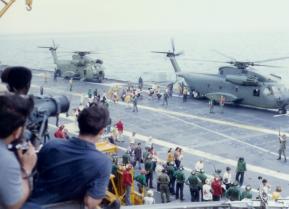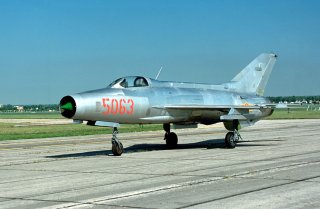The Legend of the Vietnam War’s Mystery Fighter Ace (from Vietnam)
On paper, the air war over Vietnam should have been a grossly one-sided contest. It wasn't always so.
Van Coc retired as Chief Inspector of the Vietnamese air force in 2002, while Duc Soat ended his career as Deputy Chief of the Army in 2008. Van Bay now grows mangos on a farm outside Ho Chi Minh City — an account of his meeting with one of his former aerial opponents, Col. Ralph Wetterhahn, makes for fascinating reading. Unlike American pilots, most of whom returned home after a single tour of duty, many Vietnamese pilots served for most of the conflict. Because there were so many American planes and fewer Vietnamese fighters, the best pilots racked up more aerial victories. In all, there were 16 Vietnamese aces recognized in the war.
Col. Nguyen Tomb — or “Toon” — is one of the names immortalized in military aviation, like Baron von Richthofen and Eddie Rickenbacker.
I first encountered Tomb when I was 10 years old, playing Chuck Yeager’s Air Combat on my dad’s computer. In one mission, you fly against the Vietnamese ace, infamous for having scored 13 air-to-air kills.
Tomb was the only Vietnamese pilot named in the game, and I was curious, like many others before and since, to learn more about this mysterious aviator. The top-scoring American pilots in Vietnam, by comparison, had only five kills each.
Recommended: China's H-6K: The 'Old' Bomber That Could 'Sink' the U.S. Navy
Recommended: Why an F-22 Raptor Would Crush an F-35 in a 'Dogfight'
Recommended: Air War: Stealth F-22 Raptor vs. F-14 Tomcat (That Iran Still Flies)
On paper, the air war over Vietnam should have been a grossly one-sided contest. The U.S. Air Force and Navy, the strongest air arms in the world, opposed the jets of the Vietnam People’s Air Force, averaging 70 warplanes in the early years of the air war, and peaking at 200 near the end.
It was far from one-sided. The Vietnamese received extensive technical assistance, training and replacement aircraft from Russia and China. They also drew upon decades of experience fighting materially stronger opponents.
Vietnamese MiG fighters launched hit-and-run attacks on U.S. attack formations that flew on predictable schedules, inflicting heavy losses even on supersonic F-105 Thunderchief bombers. Ground-based radars guided Vietnamese pilots into perfect ambush positions.
American aviators, in turn, had rules of engagement prohibiting them from firing missiles at unidentified aircraft or attacking enemy airfields. The Vietnamese ultimately lost more aircraft than they shot down in air-to-air combat, but they forced many air raids to abort mission and ditch their bombs.
NSA signals intelligence units spying on Vietnamese radio communications appear to be responsible for Tomb’s rise to fame. An NSA report made public through the Freedom Of Information Act, tells us how it began.
…the NSA could identify each North Vietnamese pilot by his own unique call sign suffix […] SIGINT analysts became familiar with many of the unseen North Vietnamese flyers and built case histories on individual pilots, their ranks, organizations, number of missions flown, even their combat records.
This is how they discovered Tomb, “an airborne outlaw in the image of a Wild West gunslinger” and “the first SIGINT-confirmed enemy ace.” To clarify, an “ace” is a pilot who has shot down at least five enemy aircraft.
In the NSA’s account, Tomb was such a serious threat that the commander of the U.S. 7th Air Force was “obsessed” with shooting him down, and the NSA alerted the general everytime Tomb was scheduled to fly. The report concluded with a detailed account of how the “Red Baron of North Vietnam” “single-handedly wrecked a strategic bombing mission.”
A photo also circulated of a MiG-17 numbered 3020 with over a half-dozen stars on its nose — each star representing an American plane shot down. This could only be the fighter of the infamous Tomb himself.
The MiG-17 “Fresco” evolved from the MiG-15 fighters flown extensively in the Korean War, featuring sharply swept back wings. It was a generation behind the F-4 Phantom, the top U.S. fighter of the time.
While the F-4 flew faster than Mach 2, the MiG-17 could not quite reach Mach 1 in level flight. And unlike the MiG-21 fighters in Vietnamese service, the MiG-17 couldn’t carry air-to-air missiles, relying instead on a heavy 37-millimeter and two 23-millimeter cannons. Nor did the plane have hydraulic controls, making it sluggish to handle at high speeds.
But despite these disadvantages, the MiG-17 was exceptionally maneuverable at slower speeds. Earlier in the conflict, the F-4 was plagued by its dependency on unreliable air-to-air missiles. If a MiG-17 closed into dogfighting range, it could easily out turn an F-4 and shoot it down — unless the Phantom pilot hit the throttle to disengage.
Another photo that made an impression depicted a slender MiG-21 fighter, technologically a close match for the Phantom. It was numbered 4326 and had 13 victory stars under the canopy. This too was thought to be Tomb’s fighter, because who else could have scored so many kills?
The Colonel’s Last Battle:
In 1972, the United States began Operation Linebacker, an intense aerial bombardment campaign against North Vietnam that lasted six months. On May 10, 11 North Vietnamese fighters and four F-4 Phantoms were shot down in a series of sharp engagements.
It was proving a good day for Navy Lt. Randy “Duke” Cunningham, and his back-seat radio intercept officer Lt. Junior Grade William “Irish” Driscoll.
Both were graduates of the Navy’s Top Gun school, which taught advanced air combat tactics — and they already had two kills to their names. As they flew their F-4J on a strike against the Hai Dong railyards, their formation came under attack by MiG-17s.
Cunningham turned sharply toward one and shot it down with a Sidewinder missile.
He then saw his wingman locked in a dogfight against eight MiG-17s. Several were on the tail of Cdr. Dwight Timm’s F-4. He got into firing position behind the 17s, but didn’t shoot because his heat-seeking Sidewinder missiles might have locked onto the hot twin engines of Timm’s Phantom.
“Break!” he barked at Timm. Timm complied with a sharp turn, giving Cunningham a clear shot for his second kill of the day.
The outnumbered F-4 pilots then disengaged, throttling up their engines to head for home.
Cunningham suddenly noticed a lone MiG-17 heading straight toward him. He decided to meet its approach — a nearly fatal mistake as the MiG-17 spat cannon shells at him in a head on pass.
Lacking a gun on his F-4, Cunningham swerved upwards.
The MiG-17 peeled up in pursuit — rolling over onto the Phantom’s tail. With only a short distance between them, Cunningham could see the number 3020 on the MiG.
He attempted to shake the nimble fighter with a rolling scissors maneuver, but the MiG pilot matched his Phantom’s every move.
The two aircraft burned up their energy in a series of tight turns, slowing further and further until the heavier Phantom was close to stalling.
This kind of low-speed knife-fighting was the MiG-17’s strength. Driscoll inquired nervously whether Cunningham shouldn’t abandon the fight — but Cunningham refused to give up.
Instead, he lit his afterburners, making the engine gulp fuel at a prodigious rate, and surged two miles ahead before turning around for another head on pass at the MiG, this time at an angle so the MiG couldn’t shoot back.
It didn’t work — the MiG latched immediately back on his tail.
So Cunningham disengaged and turned around a second time — but this time, as the MiG began to line up on his tail after the pass, he cut the throttle and hit the airbrakes. Denied thrust, the Phantom fell behind the MiG-17. But Cunningham’s fighter was too close for his missiles to lock onto the vulnerable MiG.
The MiG pilot rolled into a steep dive toward the ground, the heat from which would soon mask him from heat-seeking missiles.
As the MiG distanced itself from Cunningham, he fired a Sidewinder missile. It hit the MiG, which plummeted into the ground and exploded. There was no parachute in sight. Tomb had been defeated.
Shortly afterwards, an SA-2 surface-to-air missile hit Cunningham’s Phantom. Nursing his flaming fighter towards the coast, Cunningham and Driscoll ejected just over the water’s edge and were rescued at sea. They had shot down three fighters in one day, and had become the first U.S. aces in Vietnam.
Driscoll went on to work as an instructor at the Navy’s Top Gun school. Cunningham served 15 years as a Republican congressman for California before being jailed for corruption in 2005.
Legend and Myth:
As relations improved with Vietnam over the years, aviation historians began to inquire with Hanoi’s top pilots, seeking to learn more about the legendary Col. Tomb.
They all received the same reply — “Colonel who?”
None of the Vietnamese pilots had heard of Col. Tomb, and he was not in any of their records.
Tomb and “Toon” are not even Vietnamese names. (Some argue the NSA may have misheard the names “Tuan” or “Tonh.”) Most Vietnamese aces flew MiG-21s, not the older MiG-17s, and didn’t switch plane types back and forth.
Logically, there doesn’t seem to be any reason the Vietnamese air force would cover up its highest scoring ace — such an individual would have been highly celebrated. And other pilots lost in action had been commemorated, not erased from history.


